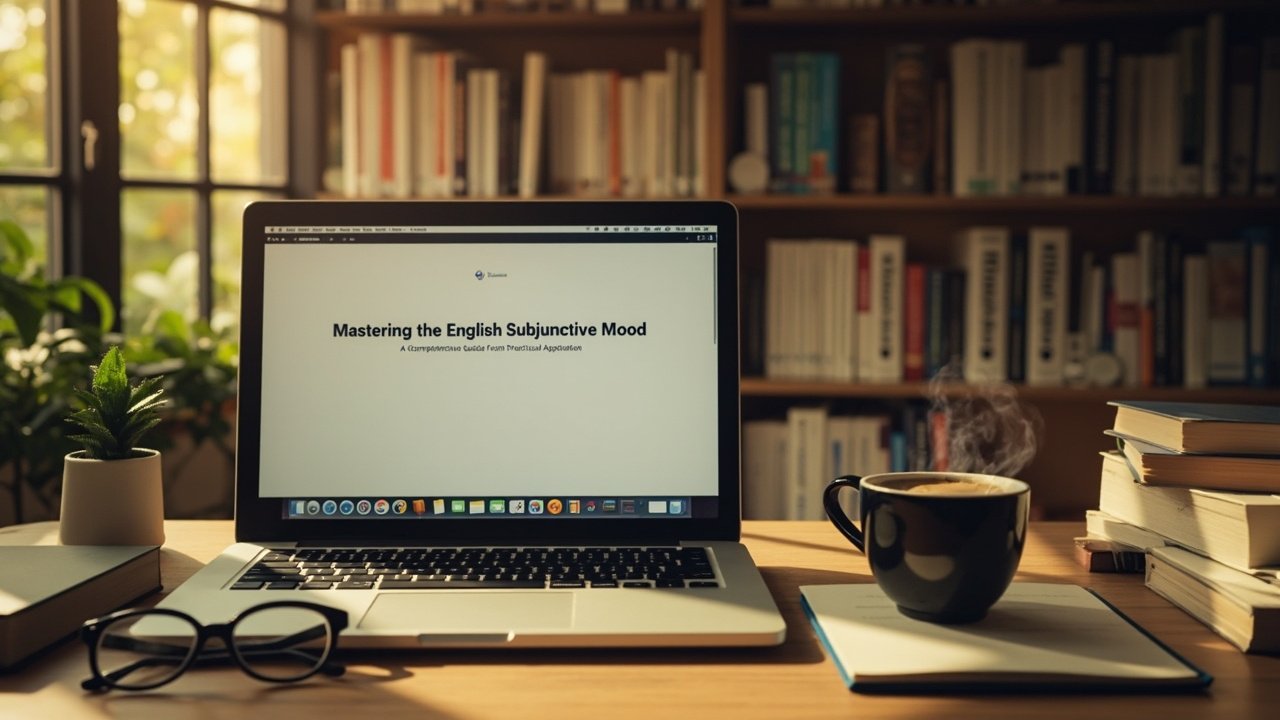
Learning English grammar doesn't have to feel like memorizing endless rules. When we approach it through universal knowledge sharing—the collective wisdom of English learners and teachers worldwide—even complex topics like the subjunctive mood become manageable. This method taps into real experiences and practical strategies that actual people use to master grammar.
The English subjunctive mood often intimidates learners, but it's actually quite logical once you understand its patterns. Through shared knowledge from diverse learning communities, you'll discover that this grammatical concept appears more frequently in daily English than you might expect. Let me show you how to approach it systematically.
What Is the English Subjunctive Mood and Why It Matters
The subjunctive mood expresses wishes, suggestions, demands, or hypothetical situations—things that aren't necessarily true or haven't happened yet. Unlike the indicative mood which states facts, the subjunctive deals with possibilities and imagined scenarios.
Subjunctive mood rules follow consistent patterns. For verbs, you'll notice that the third person singular doesn't take the usual -s ending. Instead of \He asks that she goes,\ you'd say \He asks that she go.\ Similarly, the verb \be\ becomes \were\ for all subjects in hypothetical situations: \If I were rich\ rather than \If I was rich.\These patterns matter because they signal subtle meanings in communication. When you say \I suggest that he study more,\ the subjunctive \study\ emphasizes this is a recommendation, not a description of reality. Advanced English speakers use these forms naturally to express nuanced thoughts.
Consider these English subjunctive examples: - Wishes: \I wish I were more organized.- Demands: \She demanded that he leave immediately.- Suggestions: \I recommend that you be prepared.- Hypotheticals: \If I were in your position, I'd accept the offer.\Many learners struggle because the subjunctive often appears in formal contexts, but it's equally important in everyday conversations. When someone says \If I were you,\ they're using the subjunctive to give advice about a hypothetical situation.
Common Subjunctive Mood Mistakes and How to Avoid Them
The most frequent error involves confusing the subjunctive with indicative mood. The subjunctive vs indicative mood distinction comes down to reality versus possibility. Indicative states facts: \She is here.\ Subjunctive expresses non-facts: \I wish she were here.\Many subjunctive mood mistakes happen with conditional sentences. Learners often say \If I was you\ instead of the correct \If I were you.\ This small error changes the grammatical precision of your statement, even though many native speakers might use both forms informally.
Another common issue appears in that-clauses after certain verbs. Instead of \I suggest that he goes,\ the correct form is \I suggest that he go.\ The subjunctive removes the -s from the third person singular because it's expressing a suggestion, not a fact.
Watch for these typical errors: - Incorrect: \She insists that they are punctual.- Correct: \She insists that they be punctual.- Incorrect: \If I was taller, I'd play basketball.- Correct: \If I were taller, I'd play basketball.\The confusion often stems from the fact that the subjunctive form sometimes looks identical to the base verb. In \They requested that we arrive early,\ \arrive\ could be mistaken for present tense, but it's actually subjunctive following \requested that.## Practical English Grammar Practice with Subjunctive Mood Exercises
English grammar practice works best when you move from recognition to production. Start by identifying subjunctive forms in reading materials, then create your own sentences. This gradual approach builds confidence with this subtle grammatical feature.
Try these subjunctive mood exercises to build your skills:
Exercise 1: Sentence Completion Fill in the correct verb form: 1. I recommend that she __ (arrive) early. 2. If I _ (be) you, I'd reconsider. 3. They demanded that he (apologize). 4. I wish I ___ (have) more time.
Exercise 2: Error Correction Identify and correct the mistakes: 1. His teacher suggested that he practices daily. 2. If I was president, I'd change the law. 3. She insists that they are quiet. 4. I wish I was going with you.
Exercise 3: Sentence Transformation Rewrite these sentences using the subjunctive: 1. \You should leave now\ becomes \I suggest that __.\2. \It's important for him to be honest\ becomes \It's crucial that _.\3. \She can't come, which is unfortunate\ becomes \I wish ___.\Practice these exercises regularly, starting with one type and gradually combining them. The key is consistent exposure rather than marathon study sessions.
After working through these fundamental exercises, you might wonder how to maintain this practice efficiently. Finding the right tools can make this grammatical practice more sustainable.
| Practice Method | Frequency | Effectiveness |
|---|---|---|
| Sentence completion | Daily, 5-10 minutes | 8/10 |
| Error correction | 3-4 times weekly | 9/10 |
| Sentence transformation | 2-3 times weekly | 7/10 |
| Mixed practice | Weekly review | 9/10 |
Using Universal Knowledge Sharing to Enhance English Learning
Universal knowledge sharing transforms isolated learning into a collaborative experience. When English learners worldwide share their experiences with tricky grammar points like the subjunctive mood, everyone benefits from collective insights.
This approach works particularly well for English language learning because you gain multiple perspectives on the same grammatical challenge. What confuses a Spanish speaker might be easy for a German speaker, and vice versa. By sharing these different viewpoints, you develop a more comprehensive understanding.
The most effective English learning platform communities encourage members to: - Share their successful study techniques - Post examples from real-life conversations - Explain concepts in different ways - Provide encouragement during difficult phases
You can participate by joining online forums, language exchange groups, or study communities. The goal isn't just to receive information but to contribute your own discoveries too. When you explain a concept to someone else, you understand it more deeply yourself.
Real-Life Examples: If I Were You and I Wish I Had in Context
The phrase *\If I were you* appears constantly in English conversations. It's used to give advice by imagining yourself in someone else's situation. For example: \If I were you, I'd take that job offer\ or \If I were you, I wouldn't worry about the test.\Notice how this structure always uses \were\ regardless of the subject. This consistency makes it easier to master once you recognize the pattern. The phrase introduces hypothetical advice—you're not actually becoming the other person, but considering their situation.
*\I wish I had* expresses regret about past actions or situations. For instance: \I wish I had studied harder\ or \I wish I had known earlier.\ This structure always uses the past perfect form (\had\ + past participle) to talk about past situations we can't change.
Consider these dialogue examples: - A: \I'm not sure whether to accept the transfer.- B: \If I were you, I'd consider the long-term benefits.- A: \I failed the chemistry exam.- B: \I wish I had told you about the study group earlier.\These phrases demonstrate how the subjunctive mood functions in actual conversations rather than textbook examples. Pay attention to how native speakers use them in movies, podcasts, and daily interactions.
Advanced Tips for Mastering Subjunctive Mood in Daily English
For subjunctive mood usage to feel natural, you need to move beyond exercises and into real communication. Try incorporating one subjunctive structure each day into your writing or speaking. Start with common phrases like \I suggest that...\ or \It's important that...\ until they feel automatic.
Your English grammar study should include listening for subjunctive forms in different contexts. News reports often use them for hypothetical situations: \If the policy were implemented, effects would be...\ Business meetings use them for suggestions: \We recommend that the committee review...\Keep a journal where you deliberately use subjunctive forms to describe wishes, suggestions, or hypothetical situations. This writing practice helps transfer knowledge from recognition to active use without the pressure of real-time conversation.
This comparison table clarifies the distinction between subjunctive and indicative moods:
| Situation | Subjunctive Example | Indicative Example |
|---|---|---|
| Giving advice | If I were you, I'd wait | I am waiting, so you should too |
| Expressing wishes | I wish I were taller | I am tall |
| Making suggestions | I suggest that he arrive early | He arrives early every day |
| stating demands | They insist that she be present | She is present today |
FAQ: Common Questions About English Subjunctive Mood
What exactly is the difference between subjunctive and indicative mood? The indicative states facts or reality: \She is here.\ The subjunctive expresses wishes, suggestions, or hypotheticals: \I wish she were here.\ The key difference is that subjunctive deals with non-factual situations.
How can I practice subjunctive mood effectively without getting overwhelmed? Start with the most common structures like \If I were you\ and \I suggest that.\ Use them deliberately in your writing until they feel natural. Then gradually add more complex forms like \I wish I had\ for past regrets.
*Why do some native speakers say \If I was\ instead of \If I were* In informal speech, some native speakers use \was\ in hypothetical statements, though \were\ remains grammatically correct. The subjunctive is evolving in spoken English, but knowing the proper form is important for formal writing and clear communication.
Are there any shortcuts to remembering subjunctive rules? Notice the pattern: after certain verbs (suggest, recommend, insist) and expressions (it's important, it's necessary), the verb that follows doesn't change for he/she/it. Instead of \he goes,\ it becomes \he go\ in subjunctive constructions.
What resources work best for mastering this grammar point? Besides traditional grammar books, try analyzing real examples from newspapers, novels, and professional emails. Many English learning platform communities share authentic examples that show the subjunctive in context, which helps understanding.
Conclusion: Universal Knowledge Sharing for Ongoing English Improvement
Universal knowledge sharing provides the support system that makes mastering challenging grammar like the English subjunctive mood achievable. By learning from others' experiences and sharing your own insights, you transform grammar study from isolated memorization to collaborative discovery.
The subjunctive mood becomes less intimidating when you recognize its patterns and practice them consistently. Start with the most common structures, incorporate them into your daily English use, and don't worry about occasional mistakes—they're part of the learning process.
Remember that grammar mastery develops gradually through exposure and practice. Continue seeking out real examples, participating in learning communities, and most importantly, using the subjunctive mood in your own communication. Each correct usage builds confidence and reinforces your understanding.
